
X470 Gaming Pro Carbon Review
Introduction
It’s been a while since I’ve written a motherboard review, particularly one for AMDs X470 chipset so I thought it was about time for another peoples review taking a look at an X470 chipset motherboard again. Today we will be looking at an offering from MSI the X470 Gaming Pro Carbon it is fair to say the offerings from MSI’s previous X370 generation were a mixed bag with in this reviewers opinion only two boards worth considering. The one thing MSI did however get absolutely right was the software on offer so let us get this review underway and see if MSI have managed to keep what they did well and improve upon that, or simply make all new mistakes.
Gallery
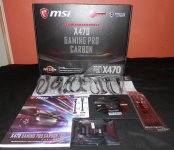
In terms of packaging and accessories the X470 Gaming Pro Carbon is packaged quite well and the box even feels like quality when you pick it up. The accessories on the other hand are, well, basic, to say the least with the standard paraphernalia included such as HB SLI bridge, IO shield, some lighting extension cables and driver DVD. I’m going to point out here that with this particular bundle MSI give you all of two SATA cables, yes really, just two. Surely MSI could have easily afforded to put an extra couple SATA cables in this bundle if they wanted to. If budget was a concern MSI could have made the instruction manual localised to the region they are selling, or better yet, make the manual digital only like almost every instruction manual is now to get the budget for the extra couple SATA cables in that way. You’d also be helping to cut down on the needless murder of trees MSI, so win-win.
Despite the very parsimonious number of provided SATA cables though this isn’t the worst accessories bundle I’ve seen MSI have at least tried to make it practical and different with all the included lighting orientated extension cables.
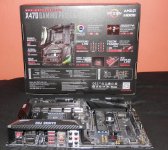
Taking a look at the back of the box and IO layout we’ll start with the information provided on the rear of the box, which is I’m happy to say focusing on technical specifications and not too much of the utterly ridiculous hyper bowl marketing and buzz words the X370 Titanium was plagued with, there’s no spelling mistakes on the back of this box unlike with the Titanium either. Early signs would suggest somebody from MSI read my Titanium review and really took it to heart when I talked about how absurd all of the marketing buzz words were.
Moving to the IO we see it is populated with 2x USB 2.0 ports, a PS/2 port, HDMI and DisplayPort, clear CMOS button, 4x USB 3.1 Gen1 (they are just USB 3.0, remember), 2x USB 3.1 Gen2 Type A and C ports, LAN port and obligatory audio jacks with SPDIF.
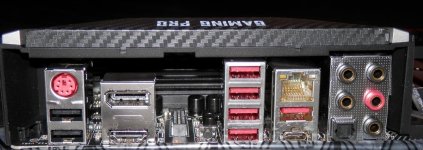
Here is a close up of the rear IO, for those that prefer that over my slightly more streamlined approach.
It’s worth noting that little port between the display and USB connections is for a WiFi module so even if you don’t get the Carbon AC model it looks like MSI have still left you with the option to add your own module, I also really like the inclusion of the clear CMOS button on the rear IO there is nothing worse than fumbling for the jumper pins or battery on the board itself should you need to do a CMOS reset it is just a shame this convenience feature is made inconvenient by the necessity to have something like a cocktail stick to poke the tiny button with. There is no BIOS flashback port however, all motherboards, regardless of price, should have some form of firmware flashback safeguard in this day and age for convenience for the user, and to cut down on RMAs the manufacturer needs to deal with. More than ever now time is not just a factor, it is money.
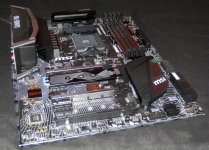
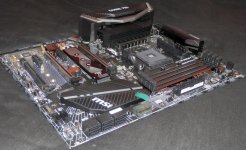
Our first look at the board itself proper, isn’t she glorious, isn’t she wonderful. The X470 Gaming Pro Carbon is easily one of the best looking X470 boards you can buy and that shroud, while yet again being a piece of plastic, is much better quality than the nasty plastic used for the shroud of the X370 Titanium. Again I should point out that all the criticisms I levied against the Titanium at this stage have been addressed with the X470 Carbon this is getting to be a little more than coincidence at this point. I think I’m going to quite enjoy reviewing this X470 Carbon but let’s not get ahead of ourselves.
Laid To Bare
We know the drill here, strip the board down and see what lay beneath, so let’s get moving.
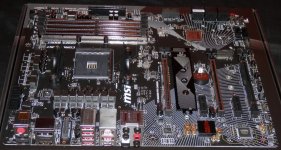
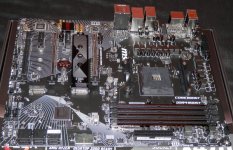
Oh my, this just keeps getting better the board looks and feels every bit as good as it did when the heatsinks were still on. Quality just oozes from this board and you will feel it the instant you pick the board up. LED placement around the board is very good too, LEDs are included on the IO shroud, there are LEDs around the chipset heatsink as well as some LEDs on the reverse of the board I’m certainly not against lighting on the rear of a board I’d just prefer something the user has a choice to mount on either the front or reverse as most people do not have clear acrylic cases, aesthetically very good all around overall.
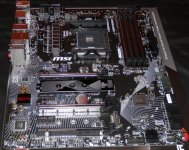
A more standard view of the board gives a much better overview of the layout and components, we see dual 8 pin CPU connections which certainly isn’t very common but if rumours are true about AMD launching a 16 core 32 thread behemoth CPU on AM4 the X470 Carbon is certainly well equipped to support it. We also see an 8+4 phase design with good clearance around the CPU socket, debug LEDs which if we are being completely honest is a poor man’s debug LED display but it’s reasonably acceptable given the Carbons price, 8x SATA ports, two of which are unfortunately somewhat crammed on and as such are poorly positioned, 2x M.2 slots, the top of which will only work with NVMe SSDs not SATA based SSDs, the capacitors appear to be the superb Nichicon 12k, and of course we have the ALC1220 under that “Audio Boost” EMI shield and intel I211AT LAN, fan headers are also well placed and perhaps best of all there is a clock generator for BCLK overclocking I’m also delighted to see (or the absence thereof) those horrid OC knobs allowing for the FP header to be back where it belongs MSI haven’t really missed a beat here it is a thoroughly impressive layout. My only minor gripe is that the heatsink on the top M.2 slot cannot be fitted on the bottom M.2 slot, some SATA based SSDs can get rather hot too MSI. Let’s dig deeper.
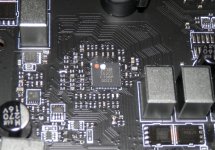
Starting with the power regulator we see MSI are using the superb Infineon IR 35201 capable of a maximum 2 outputs and 8 phases at any one time, this is certainly far superior to the Renesas 95712HRZ regulator found on the X470 Fatal1ty meaning superior voltage stability, control and regulation, etc. Moving on to the chokes, as is typical of most, there are no real markings for them these particular chokes are TR22 and TR42 they appear to be regular ferrite core as best as I can tell, there’s nothing wrong with that, but that is all I can tell you about them.

Moving to the MOSFETs we find the superb On-Semi 4C024 on the low rated for 78 Amps and on the high the equally excellent On-Semi 4C029 rated for 46 Amps. Once again there is nothing to fault here at all these are top, top quality components. So far MSI are hitting it out of the park with the choice of quality components used on the X470 Carbon there’s no grab bag of components here like the X370 Titanium suffered with it is quality through and through.
Test Your Metal
As ever for thermal load testing I will be using a DT8380 infrared temperature gun, accurate to +/- 2% and to ensure tests are as consistent as possible across reviews stock thermal pads are replaced with LAIRD 6w/mk pads. We want to test heatsink solutions and their efficiency here, not which manufacturer has the better stock thermal pads.
For those that don’t know the most efficient type of heatsink is always one that uses high grade thermal interface material, the thinner the better, good contact between heatsink and IC (a good, solid imprint of the heatsinked ICs is a sure indication of optimal contact), solid way of mounting the heatsinks, and the heatsinks themselves will have a lot of fins to maximise cooling capacity to take advantage of any natural airflow with the base of the heatsink being free of any milling marks that would hinder thermal efficiency.

Beginning with the customary look at the heatsinks and their mounting we can see that the X470 Carbon heatsinks are well made with a decent amount of fins the mounting for them is also extremely good no board warping occurs when they are screwed down and the heatsinks have a lot of heft about them all standing them in good stead for being excellent heatsinks, the surface area is also well finished with no machine milling marks ensuring good heat transfer. There’s no weak thermal epoxy this time used on the chipset heatsink we get a thin thermal pad so replacing it with TIM if you prefer is nice and easy. Once again every criticism I had with the Titanium up to this point seems to have been addressed with the Carbon clearly someone at MSI is really listening and it shows.
Now, I have seen some complain about how much of the heatsink the thermal pads cover so I’m going to make this unequivocally clear; if there is nothing to be heatsinked there is no need to have a thermal pad cover more surface area the thermal pad is there to provide heat transfer from the component(s) that do need it to the heatsink what matters is the thermodynamic design and surface area of the heatsink itself and in these areas the heatsinks on the X470 Carbon excel.
Now let’s take a look at those VRM temperature results.
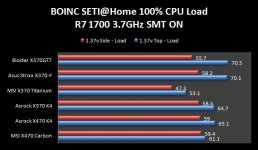
Not bad at all. The X470 Carbon results here are among some of the lowest results obtained proving once again MSI know how to engineer a heatsink, the results are some way behind those of the Titanium but the sheer size of the Titanium heatsink is what gives it the win in these tests the Carbon heatsinks by comparison are substantially smaller and do not have a heatpipe for thermal load balancing but still end up doing a superb job. There’s no shame in coming second to the best with VRM temperatures as low as this.
The UEFI – Unified Extensible Firmware Interface
The next stop is the firmware let’s see if MSI can keep their role going. All images have been taken from firmware 7B78v24.
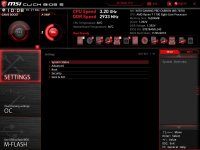
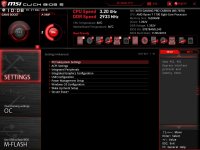
We’re off to a good start here with MSI offering a considerable amount of flexibility with the standard options they provide.
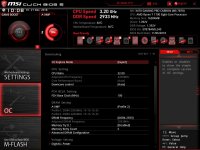
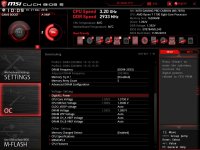
Moving on to the available overclocking options as we can see it is positively an all you can eat buffet with just about every option you could possibly ever want with an excellent layout and even an expandable tree structure so you can expose and hide many options at will making navigation that bit easier. This is truly magnificent work.
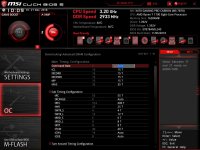
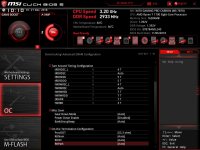
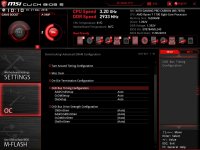
Memory options are also very thorough, there’s a couple options missing I’d have liked to see but we will get to those shortly.
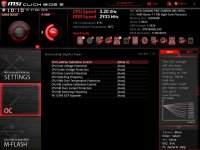
As a testament to just how much detail MSI are putting in to their firmware even when you select the level of LLC you want the graph isn’t just there as a visual aid the level of LLC you select is then highlighted on the graph to the right as well. Things like this bring a tear to my eye it is unequivocal evidence that someone has spent a long time putting in every conceivable detail they could think of such attention to detail is to be applauded.
Despite all the positives though I am very puzzled by the lack of offset voltage options meaning everything works at a constant voltage. While this is preferable for most scenarios one such scenario where it is not preferable is for the CPU I am at a complete loss as to explain why MSI did not add an offset voltage option for the CPU voltage, very, very strange. The only other minor thing to note is that there are a couple of additional DRAM options I would have liked to see, namely TRFC2 and 4 parameters but these two options being AWOL is not of any serious concern or consequence, it’s a personal preference.
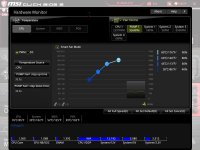
Now to take a look at the available fan control, much like everything else about the firmware it is extremely comprehensive and well laid out the only gripe I have is that there is not a way to manually key in fan values as setting the values you want via the fan graph can be a bit finicky. It is also worth mentioning that MSI have a great little feature that allows you to review any changes you have made in the firmware before saving and exiting, I really like this and wish more manufacturers would implement it.
That brings us to the end of exploring the firmware for the X470 Carbon, MSI have barely missed a step here offering far more than some other manufacturers I could name, Gigabyte. The few minor missteps MSI do make are not anything to worry too much about however the lack of a CPU voltage offset option particularly is certainly missed.
Test Setup
Now for the obligatory test system specs, we should be familiar with it by now;
CPU: AMD Zen 1700
Mainboard: MSI X470 Gaming Pro Carbon
RAM: 2x8GB G.Skill Ripjaws V 3200MHz 15-15-15-35
GPU: 4GB GTX 980 @ 1.5GHz, 7.5GHz memory
Storage: 250GB Hynix SL301 SATA SSD, WD 120GB M.2 SATA SSD (OS drive), 2TB Seagate Barracuda
Opticals: 24x Lite-On iHAS324 DVD-RW, 16x HP BH40N Blu-Ray
Sound: Xonar DX 7.1, Realtek ALC1220
PSU: EVGA 1000w Supernova G2
OS: Windows 10 Pro x64 (latest ISO) and all updates
Case: NZXT Phantom 530
Drivers:
AMD Chipset Drivers v18.10.1810
GeForce 399.24
Realtek Nahimic HD Audio Driver v6.0.1.8581
Xonar C-Media 1825 Driver
Intel l211AT Driver v23.1
Audio Analysis
Continuing on from the introduction of it with the X470 Fatal1ty K4 review the audio analysis returns for what is now a permanent new section in these peoples reviews.
The objective in this section is to more than merely test the audio and present an RMAA graph. I prefer to put an audio implementation through its paces by testing its capabilities by assaulting it with many sound sources and reverb effects all at the same time to truly test how good it is, measure the performance against a dedicated sound card and above all else to see if I can make the audio solution make any pops or cracks where it becomes overwhelmed or susceptible to EMI or crosstalk, for this purpose I will use the Metro Last Light Redux benchmark for the excellent combination it offers in these areas.
Our first overview shot of the audio.
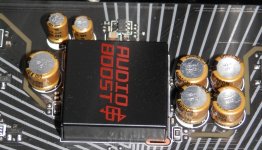
Under that “Audio Boost” EMI cover sits the ALC1220 CODEC with additional isolation on the board itself (that is what that bare PCB strip is), paired with it are Nippon Chemicon audio capacitors both 10v and 16v rated for an operating temperature up to 85c. These are some very nice audio caps but personally I favour Nichicon FGs, none the less the Chemicons are still an excellent choice but I’d wager if you were so inclined to swap them out for some Nichicon FGs with a higher voltage rating (but the same capacitance and similar diameter) you’d get better response and probably less chance of crackle and pop (how did my Rice Krispies pun go down? Call 1-800 don’t-do-that). I understand the idea going on here when the engineer designed this solution in conjunction with the trace paths; banks of capacitors perform better than a couple big capacitors however in this instance from my standpoint the engineers went too small for the number of caps used and should have gone with larger, higher voltage caps for the number of caps used in this design. On we go.
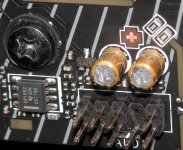
A little further down from the ALC1220 is an OP(A)1652 Texas Instruments low noise dual amplifier, now, I’m not familiar with this particular amplifier however on paper the specification is quite impressive even sporting independent circuitry for the lowest possible crosstalk and freedom of interactions between channels even if overdriven or overloaded. What I can say is that there’s really not too much muscle behind this audio solution, it’s made with top notch components but little force behind it. It’s like the 200 IQ nerd always being picked on. It was only a matter of time I suppose before something would be found where some corners had to be cut, in that regard as far as corner cutting goes this isn’t a bad compromise I just wish someone had fed the audio a few steaks. A small piece of trivia as it’s not commonly known; AMD was born thanks to Texas Instruments. Let’s move on to the audio software suit.
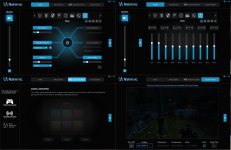
Making another appearance as it did for the Titanium is the superb Nahimic audio suit it’s not changed at all having all the same features. I do like this audio suit, it’s not as flash as the Sonic Studio suit but it’s also less clunky in navigation and use. I like less clunky. Also worth mentioning is the inclusion of the new Nahimic 3 suit however to use that you must install the universal Realtek driver and download Nahimic 3 from the Windows store. I strongly disagree with having to obtain software this way you should be able to download it all as one offline package for convenience. Our last stop will have us looking at the MSI version of the Realtek CP.
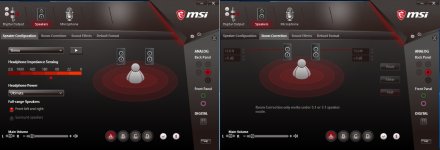
Looks nice this doesn’t it? It’s nice to use too you’ll find every basic feature you would expect to with the generic Realtek CP here but nicer looking, the more advanced features are handled by the Nahimic suit. It’s a shame both the Realtek CP and Nahimic 2 CP can’t be combined into one to make things more seamless and less clunky but using both control panels is very streamlined as it is so this is a minor grievance. What isn’t such a minor grievance though is just how long the Nahimic 2 suit takes to initially launch, we are talking 10 or more seconds here even on an SSD that is far longer than it should take this issue didn’t exist in the Titanium review so it is most likely an audio driver issue to be addressed. Our final look at audio will see us putting all of these nice features to use to see how the audio performs, let’s get started.
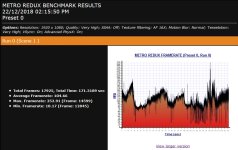
Starting with the ALC1220 results there’s nothing out of the ordinary, sound effects were handled well and as expected there were no performance issues. Unfortunately though audio crackling during this test at certain parts is present, far more so than any other board I have tested and as I suspected the audio did not have the best response I have heard with everything just a bit lacking in clarity and authority, Bass was a particular problem. Overall I’d say this implementation performs above average, but ultimately, unremarkable. It is immediately evident that this solution needs more punch and additional / better filtering.
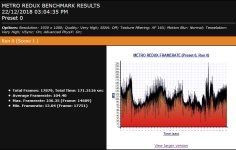
The last test sees the comparison against the Xonar DX, in terms of performance anomalies there are none however when talking about audio quality there could not be more of a difference the Xonar simply blows this implementation of the ALC1220 away.
Compared to other ALC1220 solutions this one from MSI is disappointing however it’s not all bad news in general playback the ALC1220 does rather well so if music and movies is more important to you than gaming then you won’t be disappointed.
Software
Among many software applications MSI include the Gaming LAN Manager, Command Centre, Mystic Light and the Gaming App, we’ll be taking a look at those next.
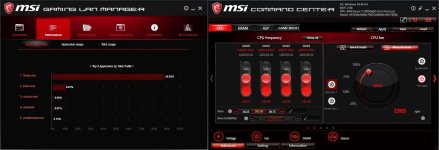
Here we have the Gaming LAN and Command Centre applications, the LAN manager allows you to monitor, test, and tweak, as the name implies, various aspects of your network and internet connection such as allowing you to prioritise gaming over media streaming and vice versa as well as file sharing and allowing you to monitor usage, the software is well laid out with a clean intuitive interface and during my time using it I did not encounter any bugs, top stuff.
Taking a look at the Command Centre next this is where you can do your overclocking from if you don’t want to do it directly from the firmware as well as manage fan control and other aspects you can easily change voltages, DRAM timings, CPU core frequency, check sensor readings, etc. Just like with the LAN manager Command Centre is well laid out and easy to use I also didn’t encounter any bugs while using the software overall very pleasing indeed.
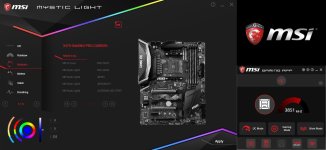
The last look at what I consider to be the most interesting of the included software brings us to the Mystic Light utility, here you can customise the on-board LEDs as well as any LEDs connected to corresponding headers. I’ve not seen any LED lighting software as flexible or comprehensive as this, like the other software Mystic Light is well laid out, slick to use and I did not encounter any bugs during my time using it for this review.
Overall the software MSI has designed here is simply fantastic and deserving of an award on its own merits alone the MSI software engineers can proudly hold their heads high for the job they have done here.
Storage Performance & Benchmarks
At last here it is, buried in the depths of this review we finally get to the benchmarks, let’s see how the X470 Carbon stacks up.
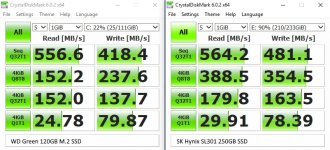
For the opening volley of benchmarks we start with Crystal Disk Mark SSD performance, this, dear readers, is exactly why I am as thorough as I am with motherboard reviews. These results are abnormal, for both good and bad reasons. Starting with the Western Digital results they are very good across the board I do find the 4KiB Q8T8 write result to be unusual though it is abnormally high for this drive. The SK Hynix SL301 results are also very good in general however the 4KiBQ32T1 read and write results are abysmal, they should be roughly double compared to what they are, just go look at the results from my Asrock X470 Fatal1ty K4 review.
The question now becomes just why are the 4KiB Q8T8 write and 4KiBQ32T1 read and write results doing what they are doing? I must have run these tests 20 times to eliminate the possibility of a one off fluke result and other random factors, as well as doing a significant amount of troubleshooting. Whatever the cause, it is one worth further investigation.
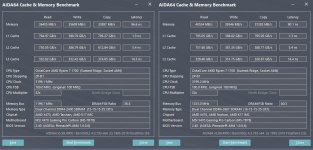
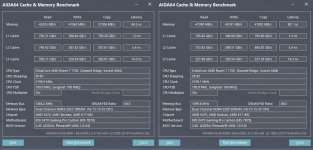
Next we have the AIDA64 results, nothing out of the ordinary here to talk about so let’s move straight on to the gaming benchmarks.
Unless otherwise stated all results have been obtained with the highest possible in-game graphical settings run at a resolution of 1920*1080 with the exception of anti-aliasing which is set to TAA or nearest equivalent if there is no nearest equivalent AA is left disabled.
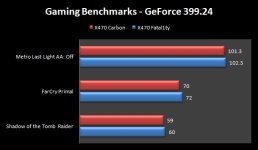
Looking at the gaming results there really isn’t anything separating the Carbon from the Fatal1ty that can be considered outside the margin of error but none the less the Fatal1ty does manage to just squeak ahead of the Carbon in each benchmark. As I’m sure some are bound to be wondering the reason I’ve used the GeForce 399.24 driver is because with all of the 4xx driver sets results for Shadow of the Tomb Raider were exceptionally poor to the tune of losing as much as 10FPS from the minimum frame rate and as much as 15FPS from average frame rates due to this regardless of if you own a 9 series or 10 series GTX card I’d strongly advise if you are playing Shadow of the Tomb Raider you run the built-in benchmark with your current driver, then try the 399.24 driver set.
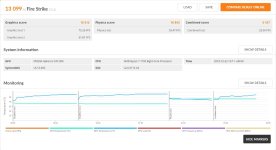
For the tried and true synthetic test Fire Strike shows a solid but not earth shattering result it could even be said the result is a hair on the low side, but it’s still not a bad result.
Overclocking
Our one final test brings us to overclocking, the X470 Carbon has certainly flaunted the potential it has in this department with the superb choice of components the board uses but now it is time to see if that potential converts in to practice.

The final OC results, both CPU and memory overclocking is up there with the best of them, I did even have a quick go for 3600MHz memory frequency and managed to have the system fairly stable at that speed however more time and in-depth tweaking would have been required to get it stable to have a fully validated OC result. It is safe to say memory overclocking has been addressed to great effect on the X470 Carbon compared to the previous X370 MSI offerings. Let’s see how the Carbon stacks up against all the other OC results.
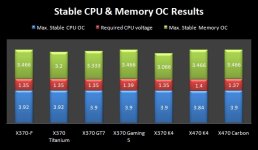
From the quick and dirty OC session with the Carbon it proved itself to be an extremely capable board and with room left in the tank still for higher memory frequencies the X470 Carbon is undoubtedly one of the best motherboards you can buy for overclocking. Also worthy of note as it is testimony to how well engineered the Carbon is are the load CPU temperatures, even while running 3.9GHz at 100% load the maximum CPU temperature did not break 73c thanks largely to adequate VRM heatsinks and good engineering keeping vital components at much more sensible temperatures. In contrast, the X470 Fatal1ty at the lower overclock of 3.84GHz saw the CPU reaching, and sometimes exceeding, 80 degrees Celsius because of inferior VRM cooling.
Let’s see how these OC results impacted gaming performance.

Unsurprisingly there isn’t much change here in average frame rates due to these titles being GPU limited rather than system limited. Metro LL being the oldest of the titles and swaying slightly more to offloading some tasks to the system does show slightly more improvement due to a slightly higher CPU frequency but this difference is once again marginal. What was observed to be of most significance though were the minimum frame rates in the Far Cry Primal test they improved by a not insignificant 5FPS while the average frame rate increased by 3FPS. I miss the days of when developers didn’t just dump everything on to the GPU to do.
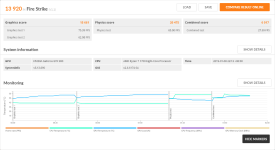
The final test sees the ever stalwart Fire Strike ran one final time returning a very surprising score, the highest score recorded to date besting even the X370-F that is quite the turnaround from the other benchmark results which are very much normal with nothing surprising or unexpected.
Conclusion
We now reach the final stretch of this peoples review. For once a motherboard review has been relatively straight forward which is certainly pleasing for me it makes this here conclusion much easier to write I’m going to break this conclusion down a bit more for a change of pace to see if we can bring some additional perspective so let’s get down to it.
Hardware Functionality & Quality: 18 / 20
From top to bottom the MSI X470 Carbon is thoroughly impressive in this category sporting some extremely fine components such as the Infineon 35201 voltage regulator, the superb On-Semi MOSFETs, a 12 phase power delivery system, from a thermodynamic standpoint quite well designed VRM heatsinks, well placed fan headers, the list goes on and on and on. Two points are deducted for the following reasons though; the top M.2 slot not supporting SATA controller based SSDs, and due to the lack of any firmware recovery feature should an update go wrong. As usual the lack of a firmware recovery feature is a sliding scale, first offences are not penalised too heavily, but repeat offences will be judged more severely. Finally I think it’s about time manufacturers once again for higher end boards like the Carbon started looking at moving on-board audio off-board to separate add-in PCBs to once and for all rid on-board audio of those highly distracting and irritating pops and cracks caused by EMI or crosstalk that is just naturally inherent of putting audio on the motherboard itself.
Accessories: 5 / 10
There isn’t much to say about the accessories, while the effort MSI has made to make the accessories both a bit different and practical is admirable ultimately it does not elevate itself to anything more than average due to the extremely stingy number of included SATA cables I can see many users with new builds falling short on the number of SATA cables they need.
Aesthetics: 10 / 10
In terms of looks the X470 Carbon is an absolutely beautiful board to look at and the plastic shroud is a substantial quality improvement over what the X370 Titanium came with. LEDs are well placed on the board and the level of LED control given to you is comprehensive, all good stuff. I’m disappointed that the awesome dragon logo has been removed from the chipset heatsink (I love dragons) as am I a little disappointed about the LEDs being mounted on the reverse of the board the much preferable solution would be to have an acrylic LED strip that could be mounted on the front or rear of the board at the users discretion depending on the type of case they have Eg; people with clear cases would perhaps prefer the LED strip on the rear of the board while users with more standard type cases would likely prefer that LED strip on the front of the board. Neither of these things are enough to deduct an points however, not in my book.
Software 10 / 10
The software for the Carbon is nothing short of phenomenal, Command Centre, LAN Manager, Mystic Light, Nahimic, every piece of software I used in the course of this review simply functioned flawlessly I did not experience a single bug and the software was also well laid out which as such made it quick and easy to navigate, nothing short of superb. The only minor oddity was how long the Nahimic control panel took to launch but this is not enough to deduct any points as after the initial launch any subsequent attempts to access the Nahimic control panel were much more responsive.
UEFI Functionality & Quality: 29 / 30
The firmware for the X470 Carbon is simply superb and worthy of an award all by itself it is the most comprehensive firmware there is down to the smallest detail the only firmware that even comes somewhat close is that offered by Asus, and to a lesser degree simply due to the more dated UI format, Asrock. There are a few chinks with the MSI firmware though things that could, I would suspect, be easily addressed in a firmware update. Those issues would be the lack of the CPU offset voltage option and TRFC 2 & 4 memory parameters, the latter of these two issues being what I would consider small fry.
Performance & Overclocking: 18 / 20
Overall performance and overclocking for the X470 Carbon is quite brilliant memory compatibility is through the roof, in fact I had far better memory overclocking results by leaving A-XMP disabled, and CPU overclocking, in a word, is stellar, the individual components of the Carbon all come together in complete harmony with the firmware and combined they really do amount to more than the sum of the parts individually.
Where the Carbon does stumble in the performance stakes is in the performance of SSDs. The cause of the poor SL301 performance for the 4KiBQ32T1 read and write results is a strange one, but none the less no amount of troubleshooting could identify a specific cause the problem remained no matter what was tried and was not present when the drive was tested on the comparison X470 Fatal1ty board.
Final Score: 90%

In closing, the MSI juggernaut has arrived offering a formidable all around package hitting a near perfect balance with hardware, firmware, and software truly deserving of the gold award. The bar has been raised, if you are a competitor either you compete competently to this stellar standard MSI is setting or you will get squashed by the MSI Behemoth.

